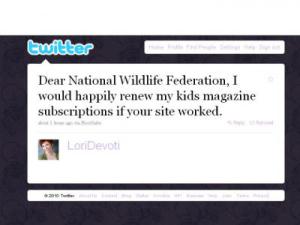"Social tools are a way to answer the phone for your readers," said Mark Coatney, director/media evangelist at tumblr. It's value is in interaction with your reader.
The four session presenters are trying different ways to chase their audiences and connect with them. Danielle Brigida, digital marketing manager at National Wildlife Fund (NWF) answered the phone and held onto a subscriber who described her problem via Twitter (see image). That told Brigida there was a problem, which she fixed. She also contacted the reader, who tried again and resubscribed, then tweeted happily about it. NWF tries many ways to reach its audience, with the motto "failing fast, failing cheap." They jump in and try lots of things, then measure how it works.
Tumblr, where anyone can set up a blog, allows lots of peer-to-peer interaction and elevates commenting, which is traditionally buried at the bottom of a website. Tumblr has reduced the barriers between consuming content and sharing it and stating your opinion. It's a good platform for sharing quickly, whether you're an individual or The Economist.
The website, GenOmics aggregates news from the genetics community for Genome Alberta, a funder of genetics research. They post material from many sources. Readers can post comments and video. Mike Spear, director of corporate communications, admits they have lots of readers, but not a lot of interaction--which he's after--yet. he invited journalists and PIOs to post original material. None of the speakers were ready to call their projects stunning successes or brilliant failures. It's still too early to tell. But NWF's Brigida noted:"I only feel like I've failed when I've missed an opportunity to learn."
Stay tuned for a posting on TBD.com's launch and the tools these new media wonks use to do their jobs.

